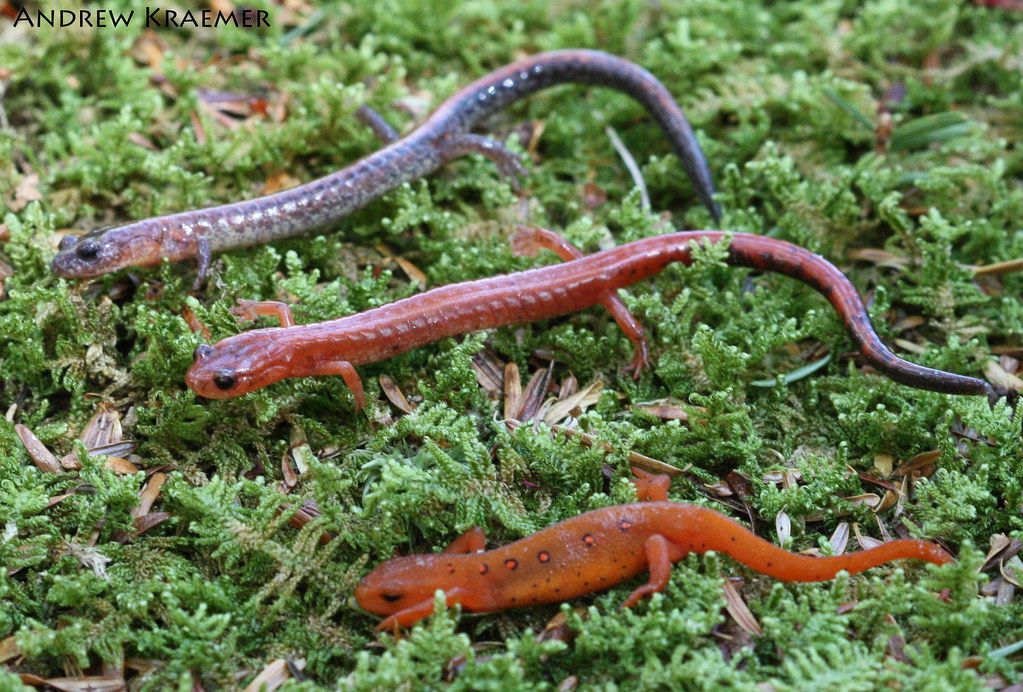北美火背蠑螈的毒性變化與其相關擬態的演化無直接相關
| 北美火焰蠑螈 (Plethodon cinereus) photo from Salamander Chronicles |
 |
| 由下而上為火焰蠑螈(model),紅背蠑螈紅化型(mimic),紅背蠑螈黑色型(non-mimetic) photo from Andy Kraemer |
摘要
The resemblance between palatable mimics and unpalatable models in Batesian mimicry systems is tempered by many factors, including the toxicity of the model species. Model toxicity is thought to influence both the occurrence of mimicry and the evolution of mimetic phenotypes, such that mimicry is most likely to persist when models are particularly toxic. Additionally, model toxicity may influence the evolution of mimetic phenotype by allowing inaccurate mimicry to evolve through a mechanism termed ‘relaxed selection’. We tested these hypotheses in a salamander mimicry system between the model Notophthalmus viridescens and the mimic Plethodon cinereus, in which N. viridescens toxicity takes the form of tetrodotoxin. Surprisingly, though we discovered geographic variation in model toxin level, we found no support for the hypotheses that model toxicity directly influences either the occurrence of mimicry or the evolution of mimic phenotype. Instead, a link between N. viridescens size and toxicity may indirectly lead to relaxed selection in this mimicry system. Additionally, limitations of predator perception or variation in the rate of phenotypic evolution of models and mimics may account for the evolution of imperfect mimicry in this salamander species. Finally, variation in predator communities among localities or modern changes in environmental conditions may contribute to the patchy occurrence of mimicry in P. cinereus.
擬態生物學裡有一個理論:想像一下,如果我們是個捕食者,在找尋獵物,突然看到一個生物看起來可以吃,咬下去之後發現,難吃但勉強能吃,為了填肚子硬吞下去,但是如果有別的選擇我可以別選這種難吃的東西,接著又發現另一隻,欸?這看起來跟剛剛那個沒這麼像,是不一樣的東西,吃下去發現,恩,好吃。回到一開始,另一個情境,一樣看到一個生物,咬下去吃後發現,這東西天殺的無敵霹靂盤古開天以來都沒那麼難吃的東西居然被我吃到!吐掉,接著又發現另一隻看起來有點像,這時你還會想嘗試第二次嗎?
這就是在說model的毒性(難吃)程度與mimic的擬態精準度之間的關係,如果model很難吃,那麼可以忍受mimic沒那麼像,如果model中等難吃,那mimic的斑紋就要像的精準一點。
| photo from Virginia Herpetological Society 紅背蠑螈的不同型態變化 |
這個研究討論的是一個具有河豚神經毒素的北美的火焰蠑螈 (Notophthalmus viridescens)的毒性程度,與牠的擬態者紅背蠑螈 (Plethodon cinereus)間斑紋變化的關係。紅背蠑螈是一個多態型的種類,而火焰蠑螈的毒性在不同地區有所差異,如果上述的理論為真的話,那麼紅背蠑螈在火焰蠑螈毒性比較高的地方擬態會比較沒那麼精準,較低的地方會比較精準。作者分為兩個方向處理,一個是對火焰蠑螈的河豚毒素(tetrodotoxin)定量,一個是從野外捕捉紅背蠑螈,藉由測量反射光譜比較擬態的精準度。
結果發現河豚毒素的多寡跟擬態的斑紋精準度沒有直接關係,反而加入火焰蠑螈體型尺寸的話還有一些間接的相關。所以這個擬態系統的演化應該還是要從當地的捕食者角度來看,才能知道這個擬態關係是如何運作。
這篇文章做了一個很重要但通常在擬態生物學都不會去做的是,就是把毒性定量出來,明確的指出毒性的變化,回到源頭就會變成副貝氏你與穆氏擬態的爭議,而這也影響捕食者對於擬態群行為上的差異。科學家其實都知道這很重要,但不做的原因大多來自於不知道確切的化合物是什麼,不知道這些毒素儲存在哪裡,沒有相關技術等等,都限制探索這些生物的化學生態的研究。目前跟擬態相關瞭解比較多的化學生態是斑蝶與毒蝶,其實還有更多東西可以等著對跨界研究有興趣的人來加入。
最後,個人看法,雖然這群作者努力的說這兩種間的擬態關係如何如何,但接連三篇的研究看完覺得,這兩種蠑螈會不會不存在擬態關係?
相關文章見此



0 comments